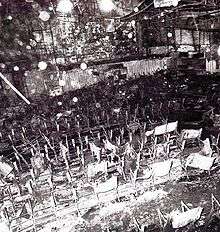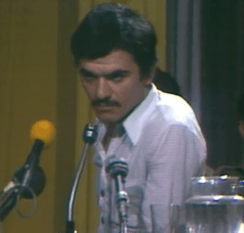Cinema Rex fire
| Cinema Rex fire | |
|---|---|
 Cinema Rex building after the fire | |
| Location | Abadan, Iran |
| Date |
19 August 1978 20:21 (IRST) |
Attack type | Arson, mass murder, terrorism |
| Deaths | 420+ |
| Perpetrators | Unknown |
Cinema Rex Fire (Persian: آتشسوزی سینما رکس) took place on 19 August 1978. The Cinema Rex, located in Abadan, Iran, was set ablaze, killing at least 420 civilians.[1] The event started when men barred the doors and doused the place with gasoline before setting it alight.[2]
The ruling Pahlavi regime of Iran initially blamed "Islamic Marxists" for the fire[3] and later reported that Islamic militants started the fire,[4][5][6][7] while the anti-Pahlavi protesters blamed the intelligence service of the nation, SAVAK for setting the fire.[8][9]
Fire
On 19 August 1978 at the Cinema Rex in Abadan, Iran, hundreds of people were watching The Deer[10] when, at 20:21, four men barred the doors of the cinema and doused it with petrol from a can. The fire started outside three entrance doors to the main hall, after the attackers allegedly dropped a match into the petrol. The attackers then fled and blocked the doors from the outside. Some people attempted to escape by the roof.[11]
Death toll
There is speculation over the actual number of casualties incurred during the fire. Some of the numbers cited by sources include 377,[12][13] 410,[14] 430,[15] 422,[16] and more than 800.[17]
Motives and responsibility


There have been numerous allegations in the past regarding the circumstances which led to the Cinema Rex fire, however it is certain that it was a key event that triggered the Iranian revolution in 1978. Initially, the revolutionaries alleged that intelligence SAVAK agents were in pursuit of individuals who ran into the movie theatre and used it as an opportunity to hide in a large crowd at the cinema. Later, either the fugitives, or the SAVAK agents chasing them decided to lock the doors of the cinema. Unable to escape from the building, everyone inside the cinema died as a result of the conflagration. The Iranian newspaper Sobhe Emruz pointed fingers at the radical Islamists in an editorial, "Don't make us disclose who were really behind the Cinema Rex fire" they said. This caused the newspaper to be shut down shortly after.[18][19][20][21][18]
Post-Islamic revolution follow up of the case
According to the Washington-based IranRights the families of the victims followed up the case and the newly established Iranian Government arrested Captain Monir Taheri. The Revolutionary Tribunal of Rudsar showed that Captain Taheri had received guerrilla training in the United States, while the defense maintained that Taheri had never visited Abadan, stressing that he was in Ahvaz at the time of the blaze. The revolutionary tribunal found Taheri "guilty" and executed him shortly thereafter on 23 February 1979.[22]
Books and references
Dillip Hiro, author of Iran Under the Ayatollahs, said that anti-Shah groups were not likely to have caused the fire, since the Cinema Rex was located in a working-class neighbourhood and was showing the film Gavaznha; Hiro added that Gavaznha "passed the censors with considerable difficulty." Hiro also said that the deliberate closure of the cinema doors and the local fire station's efforts, which Hiro described as "tepid", strengthened the public belief that the Shah had the cinema burned.[9]
According to Roy Mottahedeh, author of The Mantle of the Prophet, "thousands of Iranians who had felt neutral and had until now thought that the struggle was only between the shah and supporters of religiously conservative mullahs felt that the government might put their own lives on the block to save itself. Suddenly, for hundreds of thousands, the movement was their own business."[23]
According to Daniel L. Byman, "The movies were an affront to God, encouraging vice and Western-style decadence. So in August 1978, four Shiite revolutionaries locked the doors of the Cinema Rex in the Iranian city of Abadan and set the theater on fire…".[24]

As the event took place during the revolutionary period, it was quite difficult to make out who the perpetrator(s) was (were), making ill-conceived accusations rather prevalent. Many elements of the revolutionary bloc laid blame on Mohammad Reza Shah, the now deposed monarch of Iran, and SAVAK (Sazeman-e Ettelaat va Amniyat-e Keshvar), the country's domestic security and intelligence service. Although sufficient evidence was never brought forth to facilitate such claims, the labeling would have far-reaching implications on the subsequent direction of the revolutionary movement. The circumstances in which the fire was set did not aid in the Shah's pleas of innocence either. The timing and the location of the incident (an impoverished district of Abadan) did not coincide with preceding patterns of protestation, which raised the level of suspicion. It was also believed that the Shah specifically targeted Cinema Rex for the sole purpose of killing political dissidents who had gathered to watch a controversial anti-government film called Gavaznha (The Deer) starring well-known actor Behrouz Vossoughi.[15][25][26]
Public trial
Lasting from 25 August to 4 September 1980, the Revolutionary Tribunal would oversee seventeen court sessions that involved the trial of twenty-six individuals, including the only survivor of the four-man arson team. Hossein Takbalizadeh, the lone surviving arsonist, stated in his defense that he was an unemployed drug addict. After much deliberation, Takbalizadeh and five others were put to death in public.[27][28]
References
- ↑ "Iran: In with the madding crowd". The Economist. 3 November 2012. Retrieved 2 March 2014.
- ↑ Amuzegar, Jahangir (1991). Dynamics of the Iranian Revolution: The Pahlavis' Triumph and Tragedy. SUNY Press. ISBN 9780791407318. Retrieved 18 August 2018.
- ↑ "BBC فارسی - ايران - گاهشمار انقلاب" (in Persian). Retrieved 1 January 2018.
- ↑ Afkhami, R. Gholam (2009) The life and times of the Shah University of California Press, pages 465 & 459, ISBN 0-520-25328-0
- ↑ Ansari, M. Ali (2007) Modern Iran: the Pahlavis and after Pearson Education, page 259, ISBN 1-4058-4084-6
- ↑ Federal Research Division (2004) Iran A Country Study Kessinger Publishing, page 78, ISBN 1-4191-2670-9
- ↑ Bahl, Taru, Syed, M. H. (2003) Encyclopaedia of the Muslim World, Anmol Publications PVT. LTD., 2003, page 105, ISBN 81-261-1419-3
- ↑ Daniel, Elton L. and Mahdi, Ali Akbar (2006) Culture and Customs of Iran, Greenwood Press, Westport, Connecticut, page 106, ISBN 0-313-32053-5
- 1 2 Hiro, Dilip (1985) Iran Under the Ayatollahs Routledge and K. Paul, London, page 74, ISBN 0-7100-9924-X
- ↑ Steven Gaythorpe (24 July 2015). Cinema. Lulu.com. ISBN 978-1-326-36973-6.
- ↑ Staff, Writer. "Cinema Rex Tragedy of 1978 is Recreated in London Exhibition by Mahmoud Bakhshi". Kayhan Life. Retrieved 22 January 2017.
- ↑ William H. Blanchard (1996). Neocolonialism American Style, 1960-2000. Greenwood Publishing Group. p. 39. ISBN 978-0-313-30013-4.
- ↑ New York Times Information Bank (Firm) (1980). The Middle East: issues and events of 1978 from the New York Times Information Bank. Arno Press. p. 101. ISBN 978-0-405-12875-2.
- ↑ "The Iranian Revolution: King Pahlavi (the Shah) against Dissent". MacroHistory: The Prehistory to the 21st Century. Retrieved 21 August 2006.
- 1 2 "Abadan". Answers.com. Retrieved 21 August 2006.
- ↑ Doug Lennox (26 March 2008). Now You Know Disasters: The Little Book of Answers. Dundurn. p. 69. ISBN 978-1-4597-1810-4.
- ↑ "The Real Iranian Hostage Story". Venus Project. Archived from the original on 12 August 2006. Retrieved 21 August 2006.
- 1 2 George Bullen (14 August 2015). Nine Months in Iran. Lulu.com. p. 88. ISBN 978-1-329-43953-5.
- ↑ Annabelle Sreberny; Ali Mohammadi (1 January 1994). Small Media, Big Revolution: Communication, Culture, and the Iranian Revolution. U of Minnesota Press. p. 126. ISBN 978-0-8166-2216-0.
- ↑ Jahangir Amuzegar (1991). Dynamics of the Iranian Revolution: The Pahlavis' Triumph and Tragedy. SUNY Press. p. 250. ISBN 978-0-7914-0731-8.
- ↑ Sabine Haenni; Sarah Barrow; John White (15 September 2014). The Routledge Encyclopedia of Films. Routledge. p. 244. ISBN 978-1-317-68261-5.
- ↑ "Mr. Monir Taheri - Iran Human Rights Memorial". Iranrights.org. Retrieved 2 March 2014.
- ↑ Mottahedeh, Roy (2004). The Mantle of the Prophet: Religion and Politics in Iran, page 375.
- ↑ L. Byman, Daniel. "The Rise of Low-Tech Terrorism". w.washingtonpost. Retrieved 6 May 2007.
- ↑ "The unvanquished". Behrouz Vossoughi.com. Archived from the original on 23 October 2006. Retrieved 21 August 2006.
- ↑ "The hero and the heroin". Payvand. Retrieved 21 August 2006.
- ↑ Staff, Writer. "The cinema Rex fire was performed by SAVAK". Jamaran News.
- ↑ Ahmadiyan, Majid. "The Catastrophe of Cinema Rex the Fire of the Islamic Revolution" (PDF). cinemarexabadan.
Bibliography
- Mottahedeh, Roy P. - The Mantle of the Prophet: Religion and Politics in Iran, Oxford, Oneworld, 2000.
- Byman, Daniel L. The Rise of Low-Tech Terrorism, Washington Post, 6 May 2007: B03.